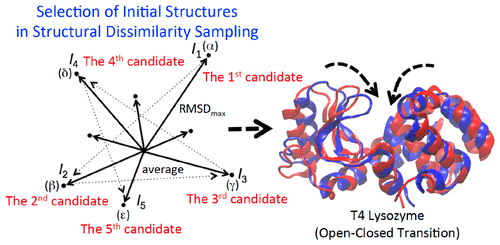当前位置:
X-MOL 学术
›
J. Chem. Inf. Model.
›
论文详情
Our official English website, www.x-mol.net, welcomes your
feedback! (Note: you will need to create a separate account there.)
Temperature-Shuffled Structural Dissimilarity Sampling Based on a Root-Mean-Square Deviation
Journal of Chemical Information and Modeling ( IF 5.6 ) Pub Date : 2018-06-08 00:00:00 , DOI: 10.1021/acs.jcim.8b00095 Ryuhei Harada 1 , Yasuteru Shigeta 1
Journal of Chemical Information and Modeling ( IF 5.6 ) Pub Date : 2018-06-08 00:00:00 , DOI: 10.1021/acs.jcim.8b00095 Ryuhei Harada 1 , Yasuteru Shigeta 1
Affiliation

|
Structural dissimilarity sampling (SDS) has been proposed as an enhanced conformational sampling method for finding neighboring metastable states of a given reactant or generating transition pathways starting from the reactant. SDS repeats a cycle of two steps: (1) selections of initial structures based on structural dissimilarities by referring to a measure and (2) conformational resampling by restarting short-time molecular dynamics (MD) simulations from the initial structures. In the present study, the measure was defined as the root-mean-square deviation (RMSD) among the resampled snapshots to characterize their structural dissimilarities. Additionally, the temperatures in restarting the short-time MD simulations were randomly shuffled at the beginning of each cycle to further promote the conformational transitions. We call this approach temperature-shuffled SDS (TSF-SDS). As a demonstration, TSF-SDS was applied to promote the open–closed transition of T4 lysozyme (T4L) in explicit water. TSF-SDS successfully reproduced the relevant domain motion with nanosecond-order simulation time, whereas conventional SDS without shuffling of the temperatures failed to promote the transition of T4L, indicating the high conformational sampling efficiency of TSF-SDS for promoting essential conformational transitions of proteins. Furthermore, as a wide-range application, TSF-SDS efficiently identified the native state of trp-cage and a dissociation process of ubiquitin dimer in explicit water.
中文翻译:

基于均方根偏差的温度混洗结构差异采样
已经提出结构不相似性采样(SDS)作为一种增强的构象采样方法,用于发现给定反应物的相邻亚稳态或从反应物开始的过渡路径。SDS重复了两个步骤的循环:(1)通过参考度量基于结构差异选择初始结构,以及(2)通过从初始结构重新启动短时分子动力学(MD)模拟来进行构象重采样。在本研究中,该度量定义为重采样快照之间的均方根偏差(RMSD),以表征其结构差异。另外,在每个循环开始时,随机重新启动短时MD模拟重新开始时的温度,以进一步促进构象转变。我们称这种方法为温度改组的SDS(TSF-SDS)。作为演示,TSF-SDS用于促进显性水中T4溶菌酶(T4L)的开闭过渡。TSF-SDS成功地以纳秒级的模拟时间再现了相关的域运动,而没有进行温度改组的常规SDS未能促进T4L的转变,表明TSF-SDS的高构象采样效率促进了蛋白质的基本构象转变。此外,作为一种广泛的应用,TSF-SDS可以有效地识别出trp-cage的天然状态以及泛素二聚体在显性水中的解离过程。TSF-SDS成功地以纳秒级的模拟时间再现了相关的域运动,而传统的SDS在不进行温度改组的情况下未能促进T4L的转变,表明TSF-SDS的高构象采样效率促进了蛋白质的基本构象转变。此外,作为一种广泛的应用,TSF-SDS可以有效地识别出trp-cage的天然状态以及泛素二聚体在显性水中的解离过程。TSF-SDS成功地以纳秒级的模拟时间再现了相关的域运动,而没有进行温度改组的常规SDS未能促进T4L的转变,表明TSF-SDS的高构象采样效率促进了蛋白质的基本构象转变。此外,作为一种广泛的应用,TSF-SDS可以有效地识别出trp-cage的天然状态以及泛素二聚体在显性水中的解离过程。
更新日期:2018-06-08
中文翻译:

基于均方根偏差的温度混洗结构差异采样
已经提出结构不相似性采样(SDS)作为一种增强的构象采样方法,用于发现给定反应物的相邻亚稳态或从反应物开始的过渡路径。SDS重复了两个步骤的循环:(1)通过参考度量基于结构差异选择初始结构,以及(2)通过从初始结构重新启动短时分子动力学(MD)模拟来进行构象重采样。在本研究中,该度量定义为重采样快照之间的均方根偏差(RMSD),以表征其结构差异。另外,在每个循环开始时,随机重新启动短时MD模拟重新开始时的温度,以进一步促进构象转变。我们称这种方法为温度改组的SDS(TSF-SDS)。作为演示,TSF-SDS用于促进显性水中T4溶菌酶(T4L)的开闭过渡。TSF-SDS成功地以纳秒级的模拟时间再现了相关的域运动,而没有进行温度改组的常规SDS未能促进T4L的转变,表明TSF-SDS的高构象采样效率促进了蛋白质的基本构象转变。此外,作为一种广泛的应用,TSF-SDS可以有效地识别出trp-cage的天然状态以及泛素二聚体在显性水中的解离过程。TSF-SDS成功地以纳秒级的模拟时间再现了相关的域运动,而传统的SDS在不进行温度改组的情况下未能促进T4L的转变,表明TSF-SDS的高构象采样效率促进了蛋白质的基本构象转变。此外,作为一种广泛的应用,TSF-SDS可以有效地识别出trp-cage的天然状态以及泛素二聚体在显性水中的解离过程。TSF-SDS成功地以纳秒级的模拟时间再现了相关的域运动,而没有进行温度改组的常规SDS未能促进T4L的转变,表明TSF-SDS的高构象采样效率促进了蛋白质的基本构象转变。此外,作为一种广泛的应用,TSF-SDS可以有效地识别出trp-cage的天然状态以及泛素二聚体在显性水中的解离过程。











































 京公网安备 11010802027423号
京公网安备 11010802027423号